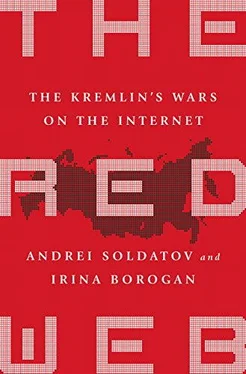The next day, however, it got worse. The traffic from hackers exploded, and the attackers changed tactics. They launched a new type of assault called DNS amplification, a popular form of DDOS in which attackers use publicly accessible open DNS servers to flood a target system. Over two days it swamped Novaya Gazeta at a rate of more than one thousand times normal traffic. [4] Konstantin Poleskov, “Eto bylo nechto!” [It Was Something!], Novaya Gazeta , April 8, 2013, www.novayagazeta.ru/society/57539.html .
“That broke down two big data centers with our equipment, which filters incoming traffic,” Afanasyev recalled. He was in a shop buying some computer stuff when a colleague called, expressing fear that the attack could cause the entire Internet in Moscow to collapse under the weight of the assault. The situation was critical, and Afanasyev decided to cut off all foreign traffic so that only users in Moscow could access Novaya Gazeta . By April 3 the attack reached a peak of sixty gigabits per second, an unheard of volume.
Kaspersky Lab asked two big telecom firms to help organize a special pathway for Novaya Gazeta in the Moscow Internet. They did, and it worked to isolate the newspaper from the digital chaos aimed at its website. At the attack’s peak the website of Novaya Gazeta was out of service only for three hours—thanks largely to Kaspersky, who played an unlikely role. He believed that malware was evil and was ready to fight it, even if it meant defending a scrappy, critical newspaper like Novaya Gazeta . [5] Ilya Azar, “I Don’t Appeal to Build a Dictatorship,” interview with Kaspersky, Lenta.ru, October 1, 2013.
In March 2013 Roskomnadzor made its first direct assault on global social networks. The agency sent a warning to Twitter when it asked the social media site to block access to five tweets and close an account, saying the offending messages were advertising narcotics and promoting suicide. On March 15 Twitter reported that the company agreed to block the tweets and deleted the account. [6] Andrei Soldatov, “What Russia Censored in March,” Index on Censorship, April 30, 2013, http://uncut.indexoncensorship.org/2013/04/what-russia-censored-in-march .
Roskomnadzor issued a special statement, expressing satisfaction with Twitter’s “constructive position.” [7] “Administratsia Twittera aktivno vkluchilas v sotrudnichestvo s Reestrom zapreshennoi k rasprostaneniyu v Rossii informatcii” [Administration of Twitter Actively Involved in Cooperation with the Register of Information Forbidden to Disseminate in Russia], Roskomnadzor statement, March 19, 2013, http://06.rkn.gov.ru/news/news48104.htm .
Then, on March 28, Roskomnadzor notified Facebook that it would be blocked unless it removed a page called “Suicide School,” which contained mostly humorous information about suicide. The site was added to Russia’s blacklist. Facebook took down the offending page. [8] Andrew E. Kramer, “Russians Selectively Blocking Internet,” New York Times , March 31, 2013, www.nytimes.com/2013/04/01/technology/russia-begins-selectively-blocking-internet-content.html .
Gradually the Russian authorities were exerting control over the Internet; Putin’s people were moving in a coordinated way. Zharov and Ksenzov at Roskomnadzor issued warnings. Meanwhile the presidential administration, a separate government body directly under Putin, held private discussions with the leaders of the digital companies, like the one that Irina Levova had been invited to earlier. Also in attendance at those discussions were Russian lawmakers who were in charge of writing repressive laws for controlling the Internet.
On May 15, 2013, Ksenzov presented to Roskomnadzor a report outlining the activities of the previous year, making it clear that he felt the government was gaining ground in its efforts to impose its will. There had been little resistance from ISPs or users. At the same time, Ksenzov expressed a worry—what if people figured out how to bypass the censorship? What if they could fool the filtering? There were methods to do this, he said, “that are relatively easy to use…. But the fact that it’s technically possible to bypass the blocking does not mean that in practice it will be done by everybody and everywhere.” [9] 9M. Ksenzov remarks, enlarged meeting of the board of Roskomnadzor, May 14, 2013, http://rkn.gov.ru/press/developments/speech/news19962.htm .
Trying to be helpful, Ksenzov recommended the agency be further targeted by blacklisting both the Internet protocol number and the URL of those websites to be blocked.
Zharov was even more cheerful. “Despite the loud and sometimes shocking attacks against these laws, in general, the laws and working with them can be evaluated positively,” he said. He noted that “among the thousands of owners of the blocked sites,” only a “very few” spoke out in public against the blacklisting. There was only one court appeal, he boasted, adding that public opinion polls showed that 82 percent of those questioned in Russia supported the law that permitted the blacklisting. [10] A. A. Zharov remarks, enlarged meeting of the board of Roskomnadzor, May 14, 2013, http://rkn.gov.ru/press/developments/speech/news19962.htm .
Zharov and Ksenzov had found a way to put pressure on the Internet companies, and the companies did not fight back. The Internet providers’ silence, first seen in Levenchuk’s experience with SORM years earlier, repeated itself. Back then the issue had been the black boxes. This time the companies did not protest government censorship.
An army of volunteers boosted the agency. Since 2012 a group calling itself Cyberguards of the Safe Internet League were patrolling the Internet, hunting down the sites with “prohibited information.” The League was launched by a group of Orthodox businessmen to promote Internet censorship under the pretext of protecting children from harmful content, with the blessing of Shchegolev, the minister of communications and media. [11] Jeffrey Peterson, “Safe Internet League Established in Russia,” EWDN , February 11, 2011, www.ewdn.com/2011/02/15/safe-internet-league-established-in-russia .
In 2014 the leader of the League proudly reported that they processed 37,400 complaints. [12] “LBI: Russkoyazichny segment interneta stanovitsa chishe” [The Safe Internet League: The Russian Segment of the Internet Is Getting Cleaner], Refnews.ru, March 2, 2015, www.refnews.ru/read/article/1061481 .
But that was not enough, and the Russian authorities appealed to pro-Kremlin youth organizations for help with Internet censoring, echoing the tactics used with patriotic-hackers and trolls. In February 2013 Molodaya Gvardiya, or Youth Guard, the youth wing of Putin’s United Russia party, launched a special unit called Media Gvardiya, or Media Guard. [13] The official site of the project is http://mediagvardia.ru .
In March 2015 this volunteer army consisted of 3,699 members who worked to identify sites with prohibited content. Due to their efforts, 2,475 pages were taken down. The site organized a competition among the members to see who could find the most sites to report to Roskomnadzor. The main goal of this effort was not to protect children but to hunt down the sites with “extremist content,” including any content unpleasant to the Kremlin.
As Putin turned the screws into Internet freedom, an event occurred in Russia he could not have predicted.
On June 23, 2013, Edward Snowden flew into Moscow’s Sheremetyevo Airport. Snowden, a former contractor for the US National Security Agency, or NSA, who had once worked in information technology for the CIA, had at this point exposed the bulk of telephone and Internet metadata of millions of Americans and people around the world, obtained by the NSA. Snowden said he leaked documents about the surveillance because the US government had obtained capabilities “without any warrant to search for, seize, and read your communications. Anyone’s communications at any time. That is the power to change people’s fates.” [14] Statement by Edward Snowden to human rights groups at Moscow’s Sheremetyevo airport, WikiLeaks, July 12, 2013, https://wikileaks.org/Statement-by-Edward-Snowden-to.html .
Читать дальше












